Analysis of Operations and Services Strategies for Watson Engineering
VerifiedAdded on 2021/02/18
|11
|3205
|476
Report
AI Summary
This report provides an in-depth analysis of operations and services management, focusing on strategies applicable to businesses like Watson Engineering. It explores various approaches, including corporate strategy, which emphasizes interconnected systems and value creation across different businesses. The report delves into customer-driven strategies, highlighting the importance of market segmentation, targeting, and differentiation. Furthermore, it examines the development of core competencies, such as well-trained staff and optimal business locations, and the role of competitive priorities like quality, cost, and flexibility. The report underscores the significance of these strategies in achieving business goals, enhancing customer satisfaction, and maintaining a competitive edge. The analysis covers key aspects of operations management, offering insights into how companies can optimize their processes and achieve sustainable growth.
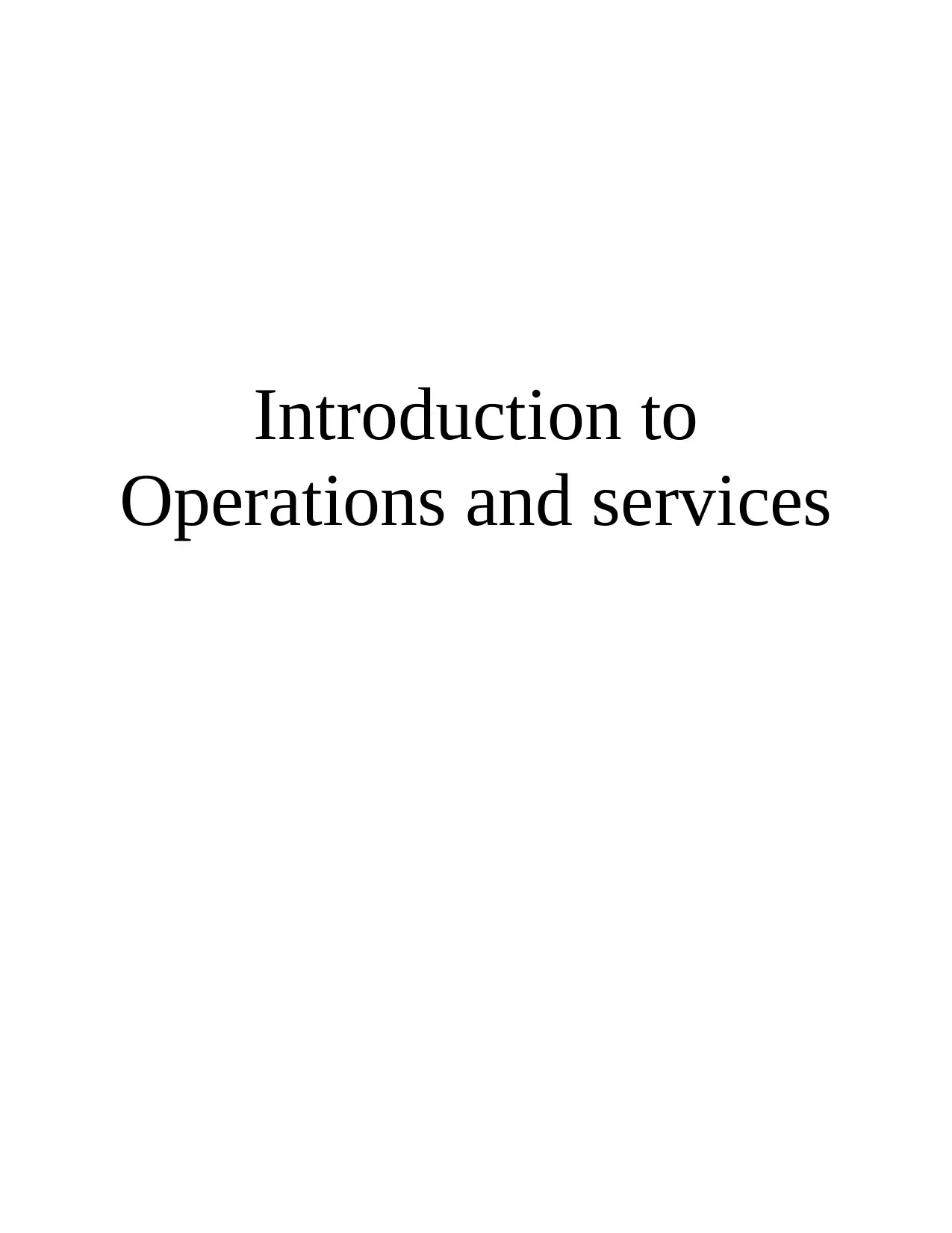
Introduction to
Operations and services
Operations and services
Paraphrase This Document
Need a fresh take? Get an instant paraphrase of this document with our AI Paraphraser

Table of Contents
INTRODUCTION...........................................................................................................................1
MAIN BODY...................................................................................................................................1
CONCLUSION................................................................................................................................7
REFERENCES................................................................................................................................8
INTRODUCTION...........................................................................................................................1
MAIN BODY...................................................................................................................................1
CONCLUSION................................................................................................................................7
REFERENCES................................................................................................................................8
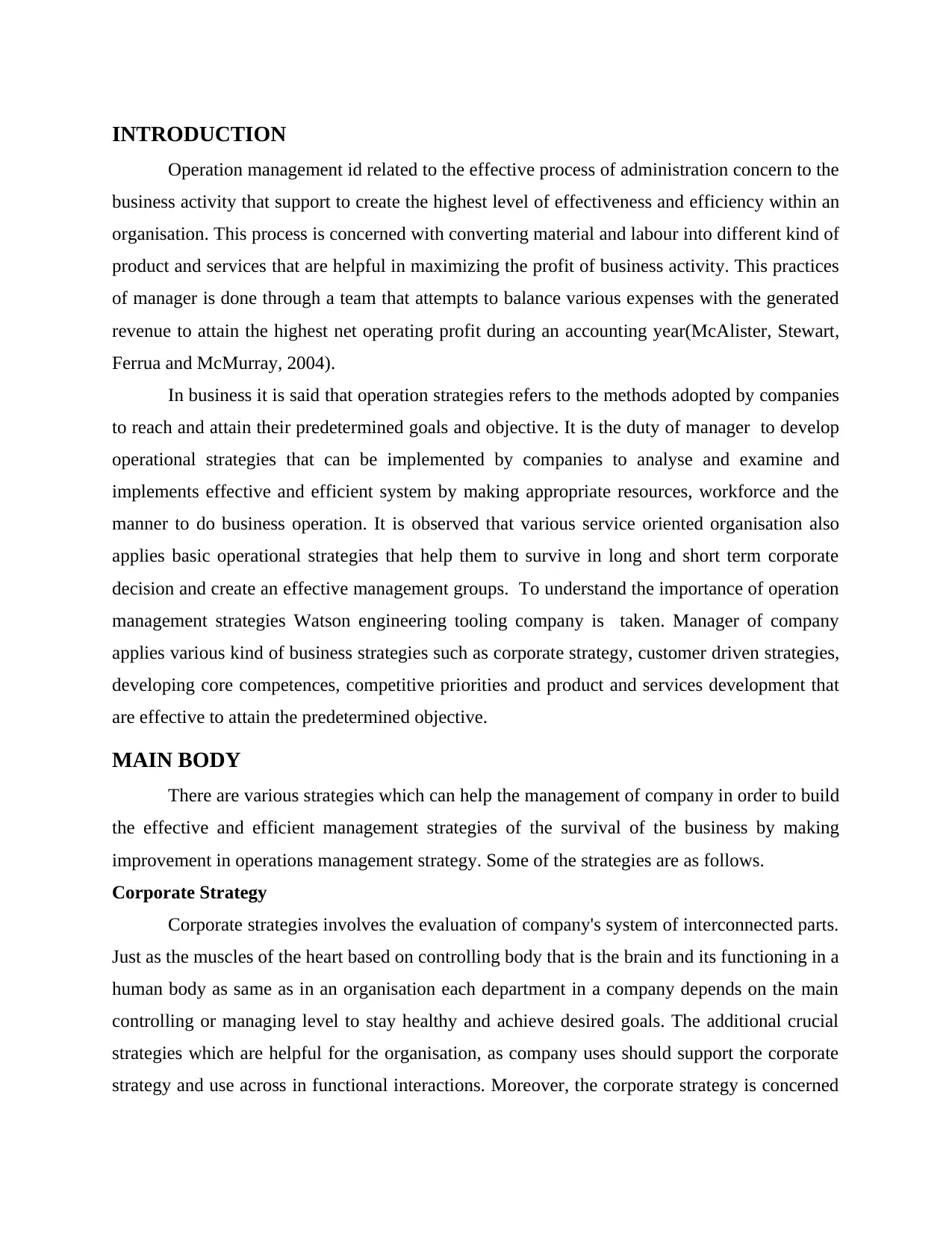
INTRODUCTION
Operation management id related to the effective process of administration concern to the
business activity that support to create the highest level of effectiveness and efficiency within an
organisation. This process is concerned with converting material and labour into different kind of
product and services that are helpful in maximizing the profit of business activity. This practices
of manager is done through a team that attempts to balance various expenses with the generated
revenue to attain the highest net operating profit during an accounting year(McAlister, Stewart,
Ferrua and McMurray, 2004).
In business it is said that operation strategies refers to the methods adopted by companies
to reach and attain their predetermined goals and objective. It is the duty of manager to develop
operational strategies that can be implemented by companies to analyse and examine and
implements effective and efficient system by making appropriate resources, workforce and the
manner to do business operation. It is observed that various service oriented organisation also
applies basic operational strategies that help them to survive in long and short term corporate
decision and create an effective management groups. To understand the importance of operation
management strategies Watson engineering tooling company is taken. Manager of company
applies various kind of business strategies such as corporate strategy, customer driven strategies,
developing core competences, competitive priorities and product and services development that
are effective to attain the predetermined objective.
MAIN BODY
There are various strategies which can help the management of company in order to build
the effective and efficient management strategies of the survival of the business by making
improvement in operations management strategy. Some of the strategies are as follows.
Corporate Strategy
Corporate strategies involves the evaluation of company's system of interconnected parts.
Just as the muscles of the heart based on controlling body that is the brain and its functioning in a
human body as same as in an organisation each department in a company depends on the main
controlling or managing level to stay healthy and achieve desired goals. The additional crucial
strategies which are helpful for the organisation, as company uses should support the corporate
strategy and use across in functional interactions. Moreover, the corporate strategy is concerned
Operation management id related to the effective process of administration concern to the
business activity that support to create the highest level of effectiveness and efficiency within an
organisation. This process is concerned with converting material and labour into different kind of
product and services that are helpful in maximizing the profit of business activity. This practices
of manager is done through a team that attempts to balance various expenses with the generated
revenue to attain the highest net operating profit during an accounting year(McAlister, Stewart,
Ferrua and McMurray, 2004).
In business it is said that operation strategies refers to the methods adopted by companies
to reach and attain their predetermined goals and objective. It is the duty of manager to develop
operational strategies that can be implemented by companies to analyse and examine and
implements effective and efficient system by making appropriate resources, workforce and the
manner to do business operation. It is observed that various service oriented organisation also
applies basic operational strategies that help them to survive in long and short term corporate
decision and create an effective management groups. To understand the importance of operation
management strategies Watson engineering tooling company is taken. Manager of company
applies various kind of business strategies such as corporate strategy, customer driven strategies,
developing core competences, competitive priorities and product and services development that
are effective to attain the predetermined objective.
MAIN BODY
There are various strategies which can help the management of company in order to build
the effective and efficient management strategies of the survival of the business by making
improvement in operations management strategy. Some of the strategies are as follows.
Corporate Strategy
Corporate strategies involves the evaluation of company's system of interconnected parts.
Just as the muscles of the heart based on controlling body that is the brain and its functioning in a
human body as same as in an organisation each department in a company depends on the main
controlling or managing level to stay healthy and achieve desired goals. The additional crucial
strategies which are helpful for the organisation, as company uses should support the corporate
strategy and use across in functional interactions. Moreover, the corporate strategy is concerned
⊘ This is a preview!⊘
Do you want full access?
Subscribe today to unlock all pages.

Trusted by 1+ million students worldwide
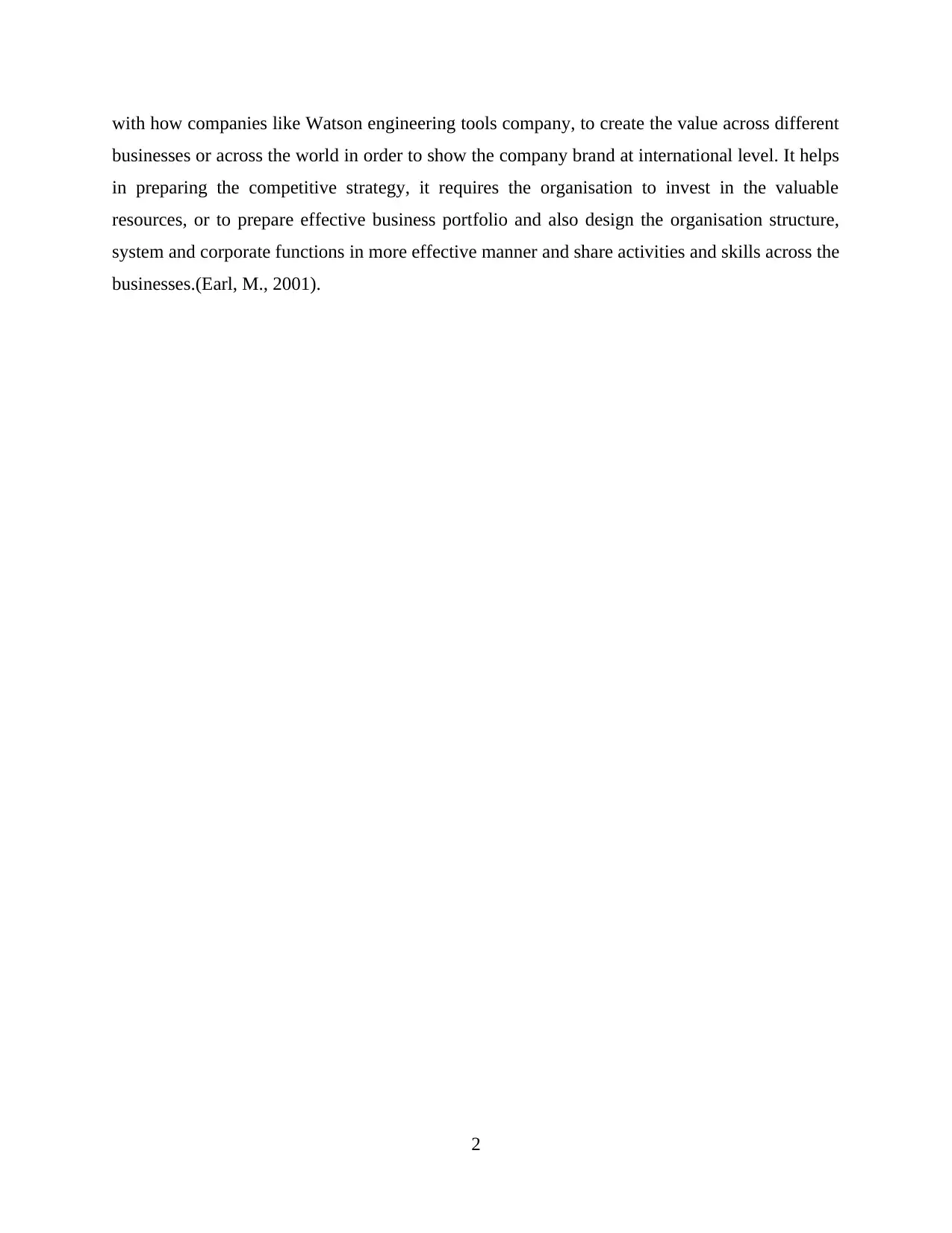
with how companies like Watson engineering tools company, to create the value across different
businesses or across the world in order to show the company brand at international level. It helps
in preparing the competitive strategy, it requires the organisation to invest in the valuable
resources, or to prepare effective business portfolio and also design the organisation structure,
system and corporate functions in more effective manner and share activities and skills across the
businesses.(Earl, M., 2001).
2
businesses or across the world in order to show the company brand at international level. It helps
in preparing the competitive strategy, it requires the organisation to invest in the valuable
resources, or to prepare effective business portfolio and also design the organisation structure,
system and corporate functions in more effective manner and share activities and skills across the
businesses.(Earl, M., 2001).
2
Paraphrase This Document
Need a fresh take? Get an instant paraphrase of this document with our AI Paraphraser
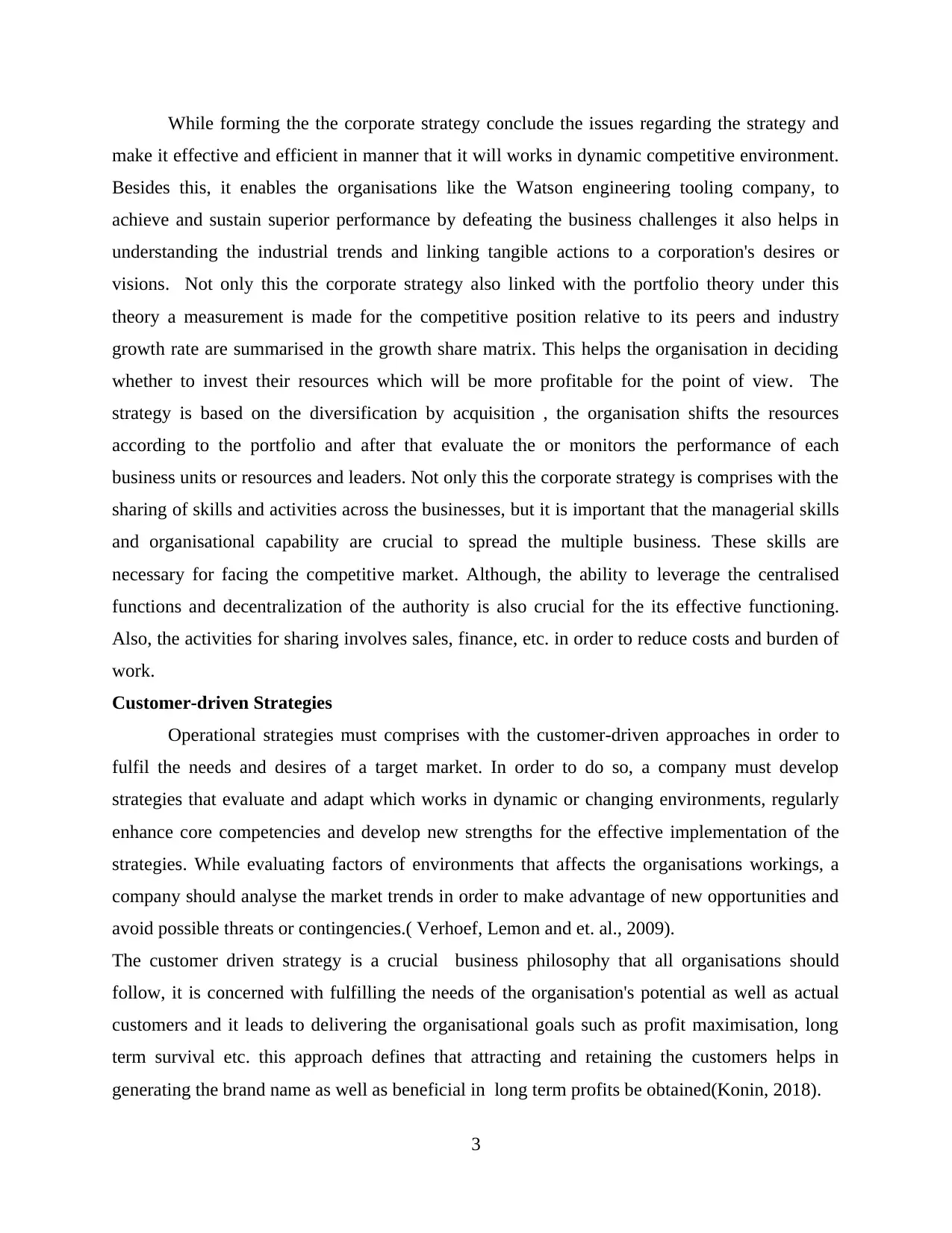
While forming the the corporate strategy conclude the issues regarding the strategy and
make it effective and efficient in manner that it will works in dynamic competitive environment.
Besides this, it enables the organisations like the Watson engineering tooling company, to
achieve and sustain superior performance by defeating the business challenges it also helps in
understanding the industrial trends and linking tangible actions to a corporation's desires or
visions. Not only this the corporate strategy also linked with the portfolio theory under this
theory a measurement is made for the competitive position relative to its peers and industry
growth rate are summarised in the growth share matrix. This helps the organisation in deciding
whether to invest their resources which will be more profitable for the point of view. The
strategy is based on the diversification by acquisition , the organisation shifts the resources
according to the portfolio and after that evaluate the or monitors the performance of each
business units or resources and leaders. Not only this the corporate strategy is comprises with the
sharing of skills and activities across the businesses, but it is important that the managerial skills
and organisational capability are crucial to spread the multiple business. These skills are
necessary for facing the competitive market. Although, the ability to leverage the centralised
functions and decentralization of the authority is also crucial for the its effective functioning.
Also, the activities for sharing involves sales, finance, etc. in order to reduce costs and burden of
work.
Customer-driven Strategies
Operational strategies must comprises with the customer-driven approaches in order to
fulfil the needs and desires of a target market. In order to do so, a company must develop
strategies that evaluate and adapt which works in dynamic or changing environments, regularly
enhance core competencies and develop new strengths for the effective implementation of the
strategies. While evaluating factors of environments that affects the organisations workings, a
company should analyse the market trends in order to make advantage of new opportunities and
avoid possible threats or contingencies.( Verhoef, Lemon and et. al., 2009).
The customer driven strategy is a crucial business philosophy that all organisations should
follow, it is concerned with fulfilling the needs of the organisation's potential as well as actual
customers and it leads to delivering the organisational goals such as profit maximisation, long
term survival etc. this approach defines that attracting and retaining the customers helps in
generating the brand name as well as beneficial in long term profits be obtained(Konin, 2018).
3
make it effective and efficient in manner that it will works in dynamic competitive environment.
Besides this, it enables the organisations like the Watson engineering tooling company, to
achieve and sustain superior performance by defeating the business challenges it also helps in
understanding the industrial trends and linking tangible actions to a corporation's desires or
visions. Not only this the corporate strategy also linked with the portfolio theory under this
theory a measurement is made for the competitive position relative to its peers and industry
growth rate are summarised in the growth share matrix. This helps the organisation in deciding
whether to invest their resources which will be more profitable for the point of view. The
strategy is based on the diversification by acquisition , the organisation shifts the resources
according to the portfolio and after that evaluate the or monitors the performance of each
business units or resources and leaders. Not only this the corporate strategy is comprises with the
sharing of skills and activities across the businesses, but it is important that the managerial skills
and organisational capability are crucial to spread the multiple business. These skills are
necessary for facing the competitive market. Although, the ability to leverage the centralised
functions and decentralization of the authority is also crucial for the its effective functioning.
Also, the activities for sharing involves sales, finance, etc. in order to reduce costs and burden of
work.
Customer-driven Strategies
Operational strategies must comprises with the customer-driven approaches in order to
fulfil the needs and desires of a target market. In order to do so, a company must develop
strategies that evaluate and adapt which works in dynamic or changing environments, regularly
enhance core competencies and develop new strengths for the effective implementation of the
strategies. While evaluating factors of environments that affects the organisations workings, a
company should analyse the market trends in order to make advantage of new opportunities and
avoid possible threats or contingencies.( Verhoef, Lemon and et. al., 2009).
The customer driven strategy is a crucial business philosophy that all organisations should
follow, it is concerned with fulfilling the needs of the organisation's potential as well as actual
customers and it leads to delivering the organisational goals such as profit maximisation, long
term survival etc. this approach defines that attracting and retaining the customers helps in
generating the brand name as well as beneficial in long term profits be obtained(Konin, 2018).
3
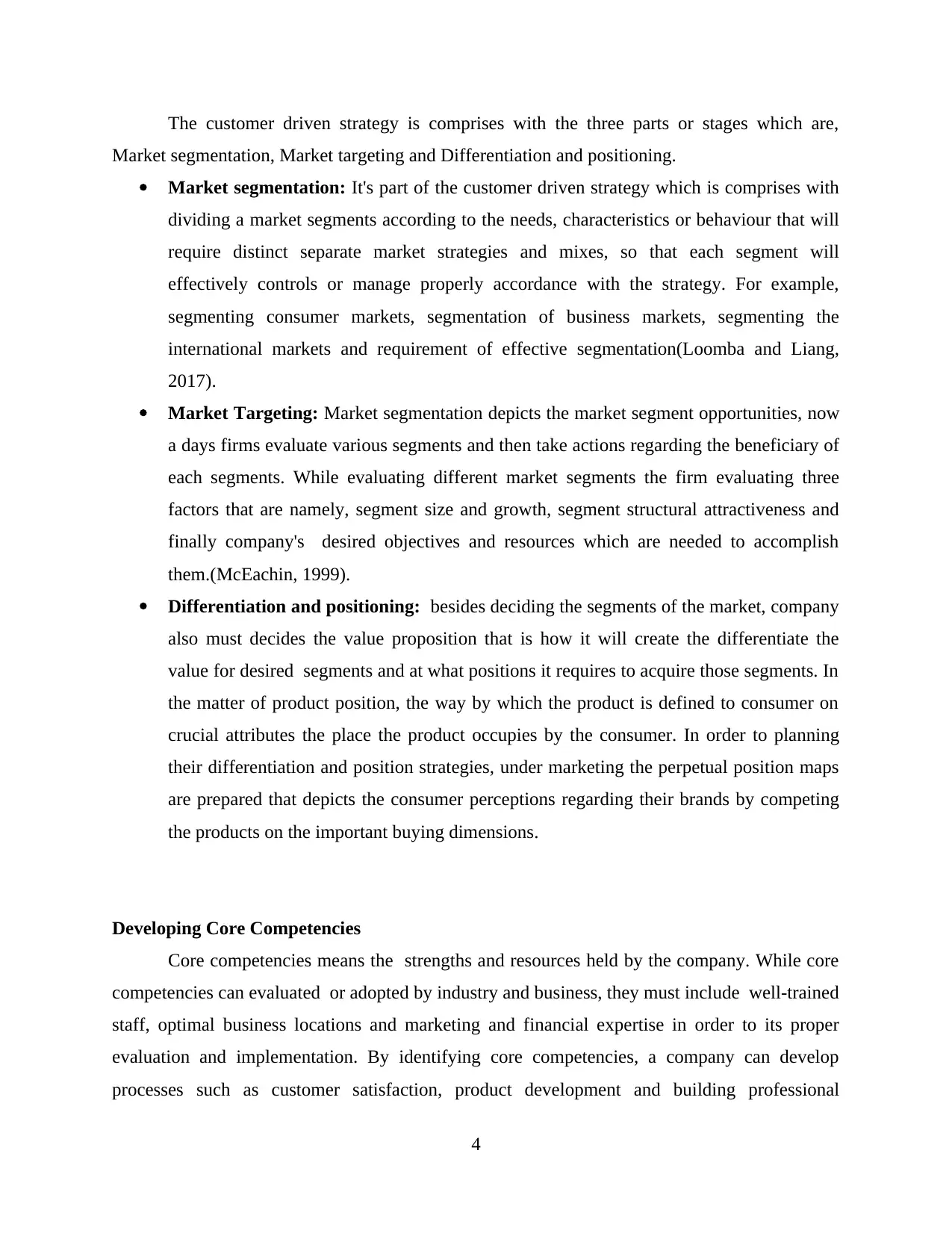
The customer driven strategy is comprises with the three parts or stages which are,
Market segmentation, Market targeting and Differentiation and positioning.
Market segmentation: It's part of the customer driven strategy which is comprises with
dividing a market segments according to the needs, characteristics or behaviour that will
require distinct separate market strategies and mixes, so that each segment will
effectively controls or manage properly accordance with the strategy. For example,
segmenting consumer markets, segmentation of business markets, segmenting the
international markets and requirement of effective segmentation(Loomba and Liang,
2017).
Market Targeting: Market segmentation depicts the market segment opportunities, now
a days firms evaluate various segments and then take actions regarding the beneficiary of
each segments. While evaluating different market segments the firm evaluating three
factors that are namely, segment size and growth, segment structural attractiveness and
finally company's desired objectives and resources which are needed to accomplish
them.(McEachin, 1999).
Differentiation and positioning: besides deciding the segments of the market, company
also must decides the value proposition that is how it will create the differentiate the
value for desired segments and at what positions it requires to acquire those segments. In
the matter of product position, the way by which the product is defined to consumer on
crucial attributes the place the product occupies by the consumer. In order to planning
their differentiation and position strategies, under marketing the perpetual position maps
are prepared that depicts the consumer perceptions regarding their brands by competing
the products on the important buying dimensions.
Developing Core Competencies
Core competencies means the strengths and resources held by the company. While core
competencies can evaluated or adopted by industry and business, they must include well-trained
staff, optimal business locations and marketing and financial expertise in order to its proper
evaluation and implementation. By identifying core competencies, a company can develop
processes such as customer satisfaction, product development and building professional
4
Market segmentation, Market targeting and Differentiation and positioning.
Market segmentation: It's part of the customer driven strategy which is comprises with
dividing a market segments according to the needs, characteristics or behaviour that will
require distinct separate market strategies and mixes, so that each segment will
effectively controls or manage properly accordance with the strategy. For example,
segmenting consumer markets, segmentation of business markets, segmenting the
international markets and requirement of effective segmentation(Loomba and Liang,
2017).
Market Targeting: Market segmentation depicts the market segment opportunities, now
a days firms evaluate various segments and then take actions regarding the beneficiary of
each segments. While evaluating different market segments the firm evaluating three
factors that are namely, segment size and growth, segment structural attractiveness and
finally company's desired objectives and resources which are needed to accomplish
them.(McEachin, 1999).
Differentiation and positioning: besides deciding the segments of the market, company
also must decides the value proposition that is how it will create the differentiate the
value for desired segments and at what positions it requires to acquire those segments. In
the matter of product position, the way by which the product is defined to consumer on
crucial attributes the place the product occupies by the consumer. In order to planning
their differentiation and position strategies, under marketing the perpetual position maps
are prepared that depicts the consumer perceptions regarding their brands by competing
the products on the important buying dimensions.
Developing Core Competencies
Core competencies means the strengths and resources held by the company. While core
competencies can evaluated or adopted by industry and business, they must include well-trained
staff, optimal business locations and marketing and financial expertise in order to its proper
evaluation and implementation. By identifying core competencies, a company can develop
processes such as customer satisfaction, product development and building professional
4
⊘ This is a preview!⊘
Do you want full access?
Subscribe today to unlock all pages.

Trusted by 1+ million students worldwide
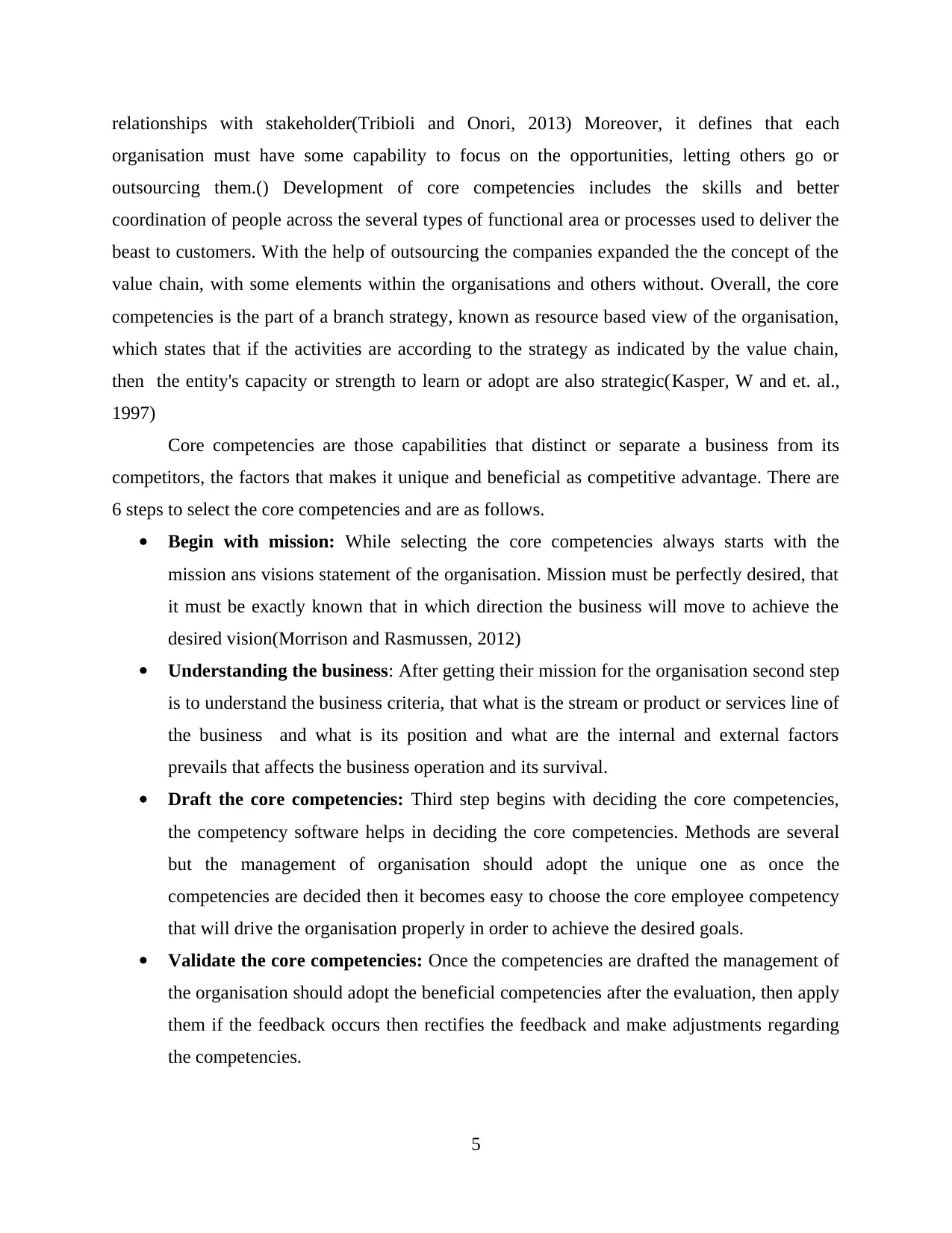
relationships with stakeholder(Tribioli and Onori, 2013) Moreover, it defines that each
organisation must have some capability to focus on the opportunities, letting others go or
outsourcing them.() Development of core competencies includes the skills and better
coordination of people across the several types of functional area or processes used to deliver the
beast to customers. With the help of outsourcing the companies expanded the the concept of the
value chain, with some elements within the organisations and others without. Overall, the core
competencies is the part of a branch strategy, known as resource based view of the organisation,
which states that if the activities are according to the strategy as indicated by the value chain,
then the entity's capacity or strength to learn or adopt are also strategic(Kasper, W and et. al.,
1997)
Core competencies are those capabilities that distinct or separate a business from its
competitors, the factors that makes it unique and beneficial as competitive advantage. There are
6 steps to select the core competencies and are as follows.
Begin with mission: While selecting the core competencies always starts with the
mission ans visions statement of the organisation. Mission must be perfectly desired, that
it must be exactly known that in which direction the business will move to achieve the
desired vision(Morrison and Rasmussen, 2012)
Understanding the business: After getting their mission for the organisation second step
is to understand the business criteria, that what is the stream or product or services line of
the business and what is its position and what are the internal and external factors
prevails that affects the business operation and its survival.
Draft the core competencies: Third step begins with deciding the core competencies,
the competency software helps in deciding the core competencies. Methods are several
but the management of organisation should adopt the unique one as once the
competencies are decided then it becomes easy to choose the core employee competency
that will drive the organisation properly in order to achieve the desired goals.
Validate the core competencies: Once the competencies are drafted the management of
the organisation should adopt the beneficial competencies after the evaluation, then apply
them if the feedback occurs then rectifies the feedback and make adjustments regarding
the competencies.
5
organisation must have some capability to focus on the opportunities, letting others go or
outsourcing them.() Development of core competencies includes the skills and better
coordination of people across the several types of functional area or processes used to deliver the
beast to customers. With the help of outsourcing the companies expanded the the concept of the
value chain, with some elements within the organisations and others without. Overall, the core
competencies is the part of a branch strategy, known as resource based view of the organisation,
which states that if the activities are according to the strategy as indicated by the value chain,
then the entity's capacity or strength to learn or adopt are also strategic(Kasper, W and et. al.,
1997)
Core competencies are those capabilities that distinct or separate a business from its
competitors, the factors that makes it unique and beneficial as competitive advantage. There are
6 steps to select the core competencies and are as follows.
Begin with mission: While selecting the core competencies always starts with the
mission ans visions statement of the organisation. Mission must be perfectly desired, that
it must be exactly known that in which direction the business will move to achieve the
desired vision(Morrison and Rasmussen, 2012)
Understanding the business: After getting their mission for the organisation second step
is to understand the business criteria, that what is the stream or product or services line of
the business and what is its position and what are the internal and external factors
prevails that affects the business operation and its survival.
Draft the core competencies: Third step begins with deciding the core competencies,
the competency software helps in deciding the core competencies. Methods are several
but the management of organisation should adopt the unique one as once the
competencies are decided then it becomes easy to choose the core employee competency
that will drive the organisation properly in order to achieve the desired goals.
Validate the core competencies: Once the competencies are drafted the management of
the organisation should adopt the beneficial competencies after the evaluation, then apply
them if the feedback occurs then rectifies the feedback and make adjustments regarding
the competencies.
5
Paraphrase This Document
Need a fresh take? Get an instant paraphrase of this document with our AI Paraphraser
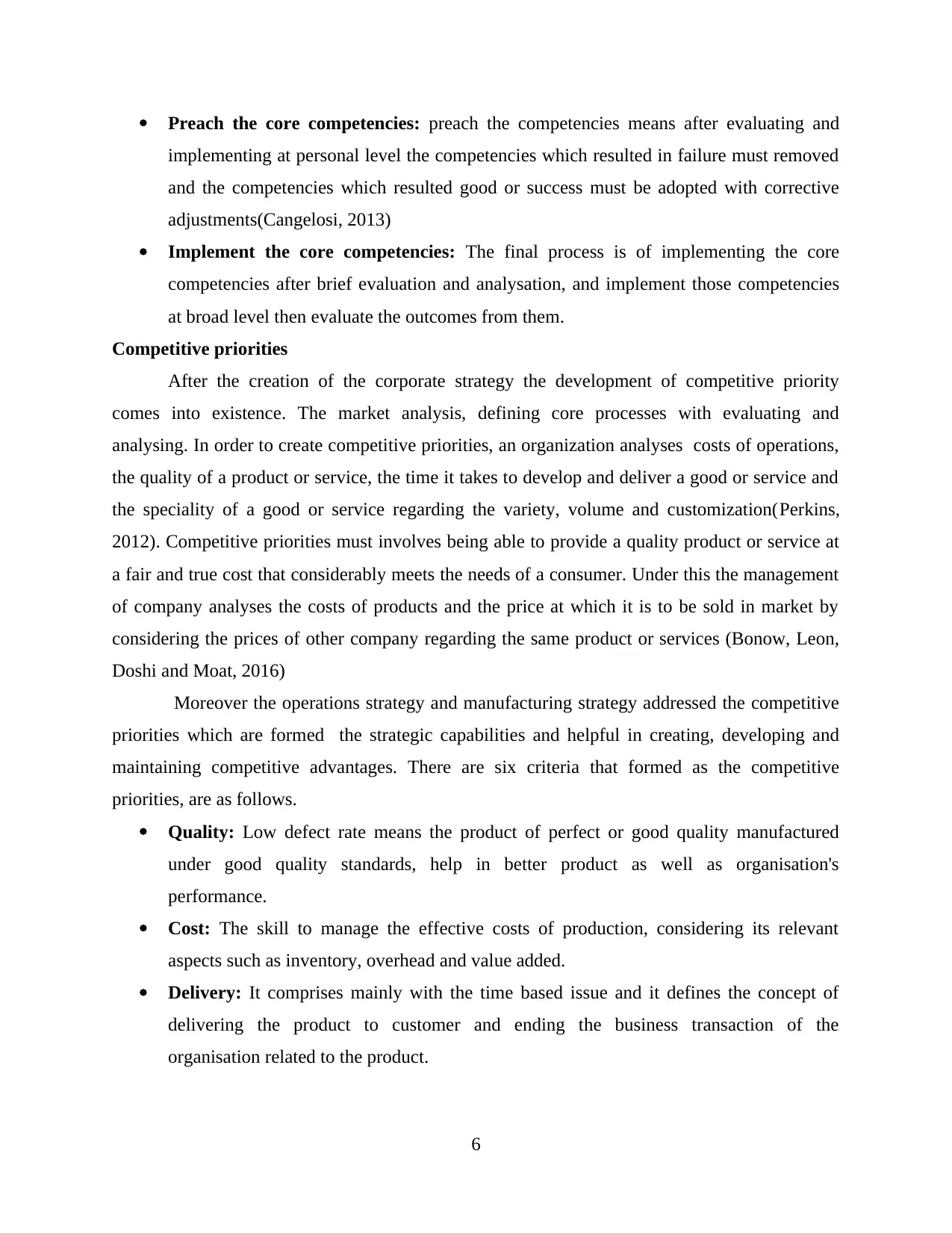
Preach the core competencies: preach the competencies means after evaluating and
implementing at personal level the competencies which resulted in failure must removed
and the competencies which resulted good or success must be adopted with corrective
adjustments(Cangelosi, 2013)
Implement the core competencies: The final process is of implementing the core
competencies after brief evaluation and analysation, and implement those competencies
at broad level then evaluate the outcomes from them.
Competitive priorities
After the creation of the corporate strategy the development of competitive priority
comes into existence. The market analysis, defining core processes with evaluating and
analysing. In order to create competitive priorities, an organization analyses costs of operations,
the quality of a product or service, the time it takes to develop and deliver a good or service and
the speciality of a good or service regarding the variety, volume and customization(Perkins,
2012). Competitive priorities must involves being able to provide a quality product or service at
a fair and true cost that considerably meets the needs of a consumer. Under this the management
of company analyses the costs of products and the price at which it is to be sold in market by
considering the prices of other company regarding the same product or services (Bonow, Leon,
Doshi and Moat, 2016)
Moreover the operations strategy and manufacturing strategy addressed the competitive
priorities which are formed the strategic capabilities and helpful in creating, developing and
maintaining competitive advantages. There are six criteria that formed as the competitive
priorities, are as follows.
Quality: Low defect rate means the product of perfect or good quality manufactured
under good quality standards, help in better product as well as organisation's
performance.
Cost: The skill to manage the effective costs of production, considering its relevant
aspects such as inventory, overhead and value added.
Delivery: It comprises mainly with the time based issue and it defines the concept of
delivering the product to customer and ending the business transaction of the
organisation related to the product.
6
implementing at personal level the competencies which resulted in failure must removed
and the competencies which resulted good or success must be adopted with corrective
adjustments(Cangelosi, 2013)
Implement the core competencies: The final process is of implementing the core
competencies after brief evaluation and analysation, and implement those competencies
at broad level then evaluate the outcomes from them.
Competitive priorities
After the creation of the corporate strategy the development of competitive priority
comes into existence. The market analysis, defining core processes with evaluating and
analysing. In order to create competitive priorities, an organization analyses costs of operations,
the quality of a product or service, the time it takes to develop and deliver a good or service and
the speciality of a good or service regarding the variety, volume and customization(Perkins,
2012). Competitive priorities must involves being able to provide a quality product or service at
a fair and true cost that considerably meets the needs of a consumer. Under this the management
of company analyses the costs of products and the price at which it is to be sold in market by
considering the prices of other company regarding the same product or services (Bonow, Leon,
Doshi and Moat, 2016)
Moreover the operations strategy and manufacturing strategy addressed the competitive
priorities which are formed the strategic capabilities and helpful in creating, developing and
maintaining competitive advantages. There are six criteria that formed as the competitive
priorities, are as follows.
Quality: Low defect rate means the product of perfect or good quality manufactured
under good quality standards, help in better product as well as organisation's
performance.
Cost: The skill to manage the effective costs of production, considering its relevant
aspects such as inventory, overhead and value added.
Delivery: It comprises mainly with the time based issue and it defines the concept of
delivering the product to customer and ending the business transaction of the
organisation related to the product.
6
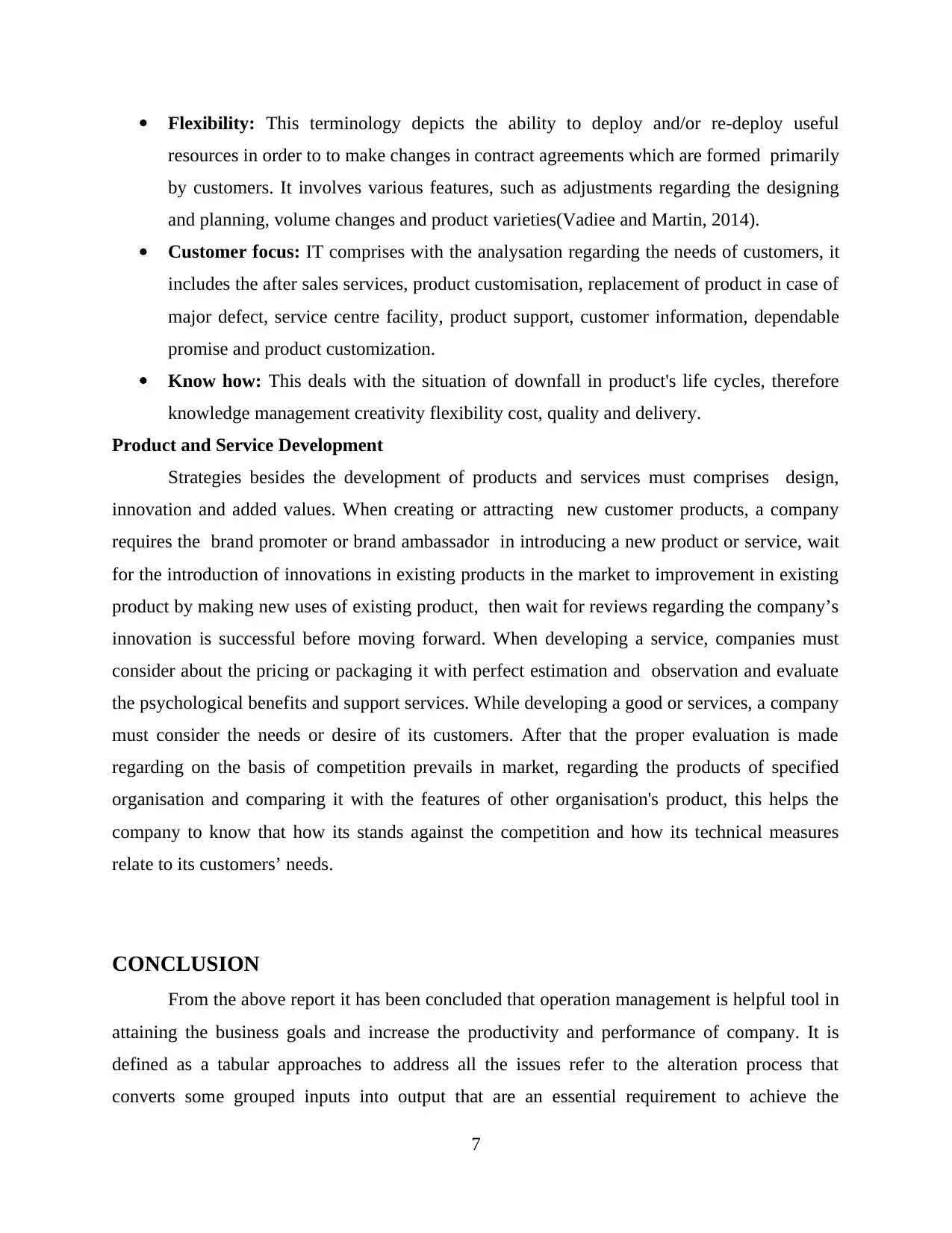
Flexibility: This terminology depicts the ability to deploy and/or re-deploy useful
resources in order to to make changes in contract agreements which are formed primarily
by customers. It involves various features, such as adjustments regarding the designing
and planning, volume changes and product varieties(Vadiee and Martin, 2014).
Customer focus: IT comprises with the analysation regarding the needs of customers, it
includes the after sales services, product customisation, replacement of product in case of
major defect, service centre facility, product support, customer information, dependable
promise and product customization.
Know how: This deals with the situation of downfall in product's life cycles, therefore
knowledge management creativity flexibility cost, quality and delivery.
Product and Service Development
Strategies besides the development of products and services must comprises design,
innovation and added values. When creating or attracting new customer products, a company
requires the brand promoter or brand ambassador in introducing a new product or service, wait
for the introduction of innovations in existing products in the market to improvement in existing
product by making new uses of existing product, then wait for reviews regarding the company’s
innovation is successful before moving forward. When developing a service, companies must
consider about the pricing or packaging it with perfect estimation and observation and evaluate
the psychological benefits and support services. While developing a good or services, a company
must consider the needs or desire of its customers. After that the proper evaluation is made
regarding on the basis of competition prevails in market, regarding the products of specified
organisation and comparing it with the features of other organisation's product, this helps the
company to know that how its stands against the competition and how its technical measures
relate to its customers’ needs.
CONCLUSION
From the above report it has been concluded that operation management is helpful tool in
attaining the business goals and increase the productivity and performance of company. It is
defined as a tabular approaches to address all the issues refer to the alteration process that
converts some grouped inputs into output that are an essential requirement to achieve the
7
resources in order to to make changes in contract agreements which are formed primarily
by customers. It involves various features, such as adjustments regarding the designing
and planning, volume changes and product varieties(Vadiee and Martin, 2014).
Customer focus: IT comprises with the analysation regarding the needs of customers, it
includes the after sales services, product customisation, replacement of product in case of
major defect, service centre facility, product support, customer information, dependable
promise and product customization.
Know how: This deals with the situation of downfall in product's life cycles, therefore
knowledge management creativity flexibility cost, quality and delivery.
Product and Service Development
Strategies besides the development of products and services must comprises design,
innovation and added values. When creating or attracting new customer products, a company
requires the brand promoter or brand ambassador in introducing a new product or service, wait
for the introduction of innovations in existing products in the market to improvement in existing
product by making new uses of existing product, then wait for reviews regarding the company’s
innovation is successful before moving forward. When developing a service, companies must
consider about the pricing or packaging it with perfect estimation and observation and evaluate
the psychological benefits and support services. While developing a good or services, a company
must consider the needs or desire of its customers. After that the proper evaluation is made
regarding on the basis of competition prevails in market, regarding the products of specified
organisation and comparing it with the features of other organisation's product, this helps the
company to know that how its stands against the competition and how its technical measures
relate to its customers’ needs.
CONCLUSION
From the above report it has been concluded that operation management is helpful tool in
attaining the business goals and increase the productivity and performance of company. It is
defined as a tabular approaches to address all the issues refer to the alteration process that
converts some grouped inputs into output that are an essential requirement to achieve the
7
⊘ This is a preview!⊘
Do you want full access?
Subscribe today to unlock all pages.

Trusted by 1+ million students worldwide
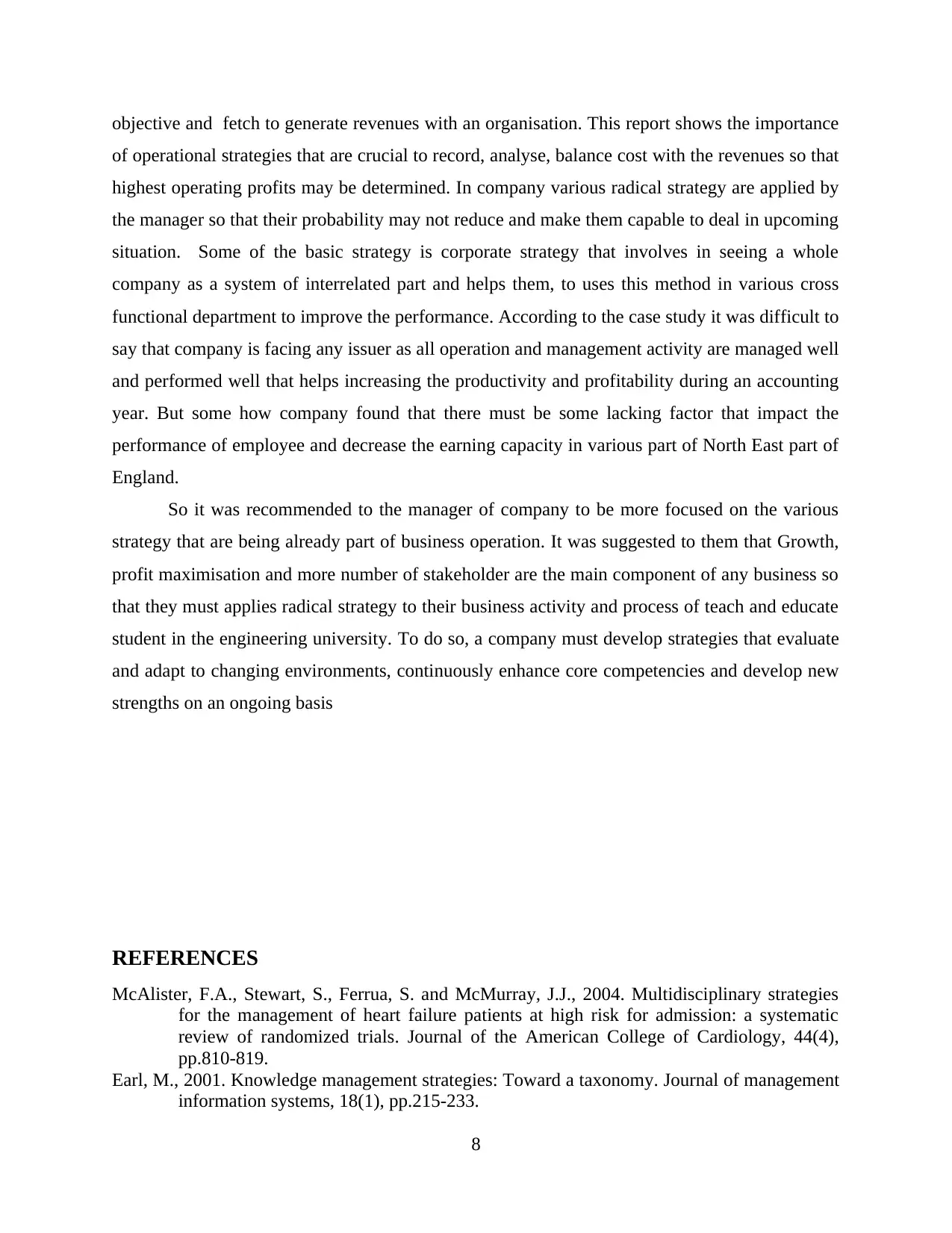
objective and fetch to generate revenues with an organisation. This report shows the importance
of operational strategies that are crucial to record, analyse, balance cost with the revenues so that
highest operating profits may be determined. In company various radical strategy are applied by
the manager so that their probability may not reduce and make them capable to deal in upcoming
situation. Some of the basic strategy is corporate strategy that involves in seeing a whole
company as a system of interrelated part and helps them, to uses this method in various cross
functional department to improve the performance. According to the case study it was difficult to
say that company is facing any issuer as all operation and management activity are managed well
and performed well that helps increasing the productivity and profitability during an accounting
year. But some how company found that there must be some lacking factor that impact the
performance of employee and decrease the earning capacity in various part of North East part of
England.
So it was recommended to the manager of company to be more focused on the various
strategy that are being already part of business operation. It was suggested to them that Growth,
profit maximisation and more number of stakeholder are the main component of any business so
that they must applies radical strategy to their business activity and process of teach and educate
student in the engineering university. To do so, a company must develop strategies that evaluate
and adapt to changing environments, continuously enhance core competencies and develop new
strengths on an ongoing basis
REFERENCES
McAlister, F.A., Stewart, S., Ferrua, S. and McMurray, J.J., 2004. Multidisciplinary strategies
for the management of heart failure patients at high risk for admission: a systematic
review of randomized trials. Journal of the American College of Cardiology, 44(4),
pp.810-819.
Earl, M., 2001. Knowledge management strategies: Toward a taxonomy. Journal of management
information systems, 18(1), pp.215-233.
8
of operational strategies that are crucial to record, analyse, balance cost with the revenues so that
highest operating profits may be determined. In company various radical strategy are applied by
the manager so that their probability may not reduce and make them capable to deal in upcoming
situation. Some of the basic strategy is corporate strategy that involves in seeing a whole
company as a system of interrelated part and helps them, to uses this method in various cross
functional department to improve the performance. According to the case study it was difficult to
say that company is facing any issuer as all operation and management activity are managed well
and performed well that helps increasing the productivity and profitability during an accounting
year. But some how company found that there must be some lacking factor that impact the
performance of employee and decrease the earning capacity in various part of North East part of
England.
So it was recommended to the manager of company to be more focused on the various
strategy that are being already part of business operation. It was suggested to them that Growth,
profit maximisation and more number of stakeholder are the main component of any business so
that they must applies radical strategy to their business activity and process of teach and educate
student in the engineering university. To do so, a company must develop strategies that evaluate
and adapt to changing environments, continuously enhance core competencies and develop new
strengths on an ongoing basis
REFERENCES
McAlister, F.A., Stewart, S., Ferrua, S. and McMurray, J.J., 2004. Multidisciplinary strategies
for the management of heart failure patients at high risk for admission: a systematic
review of randomized trials. Journal of the American College of Cardiology, 44(4),
pp.810-819.
Earl, M., 2001. Knowledge management strategies: Toward a taxonomy. Journal of management
information systems, 18(1), pp.215-233.
8
Paraphrase This Document
Need a fresh take? Get an instant paraphrase of this document with our AI Paraphraser
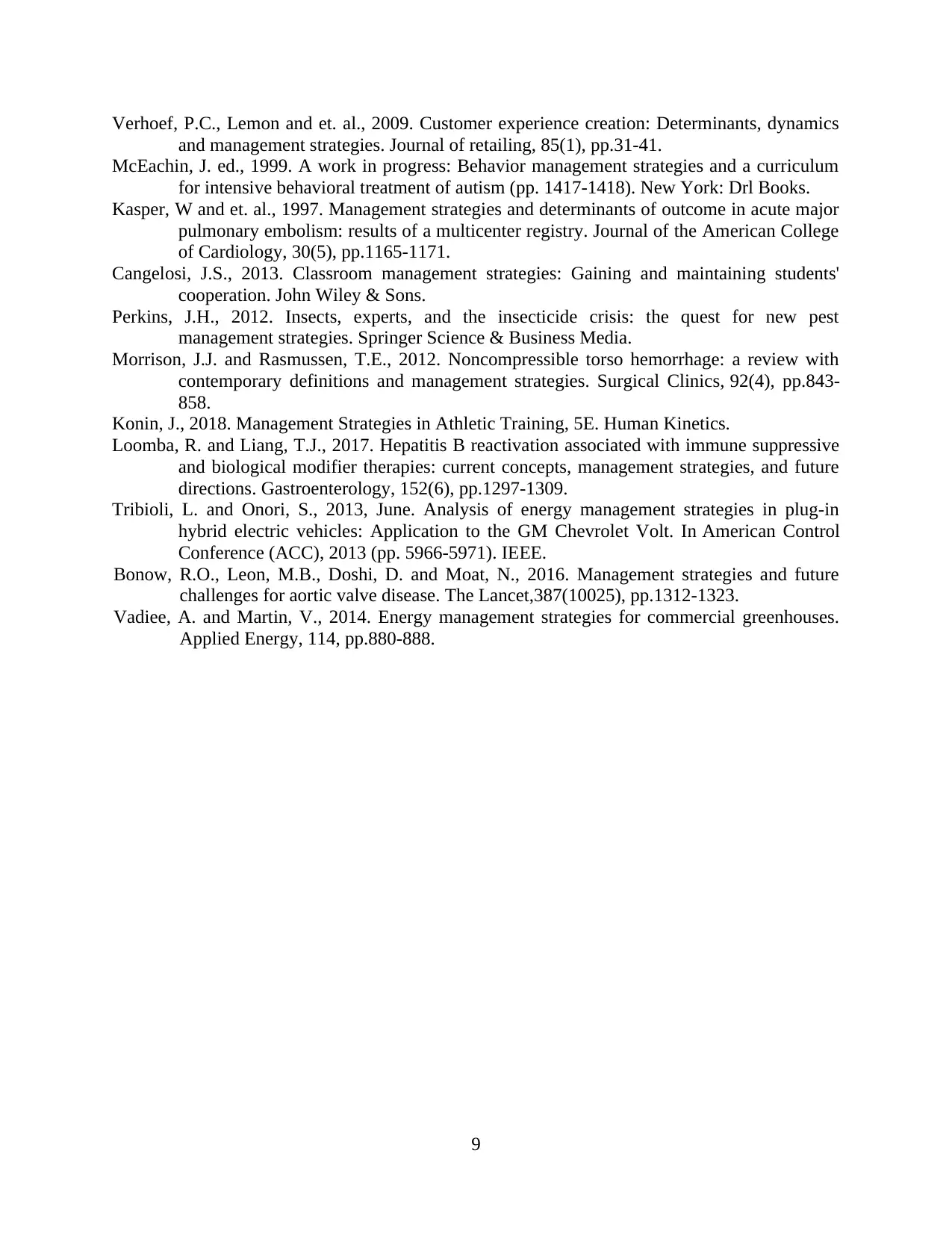
Verhoef, P.C., Lemon and et. al., 2009. Customer experience creation: Determinants, dynamics
and management strategies. Journal of retailing, 85(1), pp.31-41.
McEachin, J. ed., 1999. A work in progress: Behavior management strategies and a curriculum
for intensive behavioral treatment of autism (pp. 1417-1418). New York: Drl Books.
Kasper, W and et. al., 1997. Management strategies and determinants of outcome in acute major
pulmonary embolism: results of a multicenter registry. Journal of the American College
of Cardiology, 30(5), pp.1165-1171.
Cangelosi, J.S., 2013. Classroom management strategies: Gaining and maintaining students'
cooperation. John Wiley & Sons.
Perkins, J.H., 2012. Insects, experts, and the insecticide crisis: the quest for new pest
management strategies. Springer Science & Business Media.
Morrison, J.J. and Rasmussen, T.E., 2012. Noncompressible torso hemorrhage: a review with
contemporary definitions and management strategies. Surgical Clinics, 92(4), pp.843-
858.
Konin, J., 2018. Management Strategies in Athletic Training, 5E. Human Kinetics.
Loomba, R. and Liang, T.J., 2017. Hepatitis B reactivation associated with immune suppressive
and biological modifier therapies: current concepts, management strategies, and future
directions. Gastroenterology, 152(6), pp.1297-1309.
Tribioli, L. and Onori, S., 2013, June. Analysis of energy management strategies in plug-in
hybrid electric vehicles: Application to the GM Chevrolet Volt. In American Control
Conference (ACC), 2013 (pp. 5966-5971). IEEE.
Bonow, R.O., Leon, M.B., Doshi, D. and Moat, N., 2016. Management strategies and future
challenges for aortic valve disease. The Lancet,387(10025), pp.1312-1323.
Vadiee, A. and Martin, V., 2014. Energy management strategies for commercial greenhouses.
Applied Energy, 114, pp.880-888.
9
and management strategies. Journal of retailing, 85(1), pp.31-41.
McEachin, J. ed., 1999. A work in progress: Behavior management strategies and a curriculum
for intensive behavioral treatment of autism (pp. 1417-1418). New York: Drl Books.
Kasper, W and et. al., 1997. Management strategies and determinants of outcome in acute major
pulmonary embolism: results of a multicenter registry. Journal of the American College
of Cardiology, 30(5), pp.1165-1171.
Cangelosi, J.S., 2013. Classroom management strategies: Gaining and maintaining students'
cooperation. John Wiley & Sons.
Perkins, J.H., 2012. Insects, experts, and the insecticide crisis: the quest for new pest
management strategies. Springer Science & Business Media.
Morrison, J.J. and Rasmussen, T.E., 2012. Noncompressible torso hemorrhage: a review with
contemporary definitions and management strategies. Surgical Clinics, 92(4), pp.843-
858.
Konin, J., 2018. Management Strategies in Athletic Training, 5E. Human Kinetics.
Loomba, R. and Liang, T.J., 2017. Hepatitis B reactivation associated with immune suppressive
and biological modifier therapies: current concepts, management strategies, and future
directions. Gastroenterology, 152(6), pp.1297-1309.
Tribioli, L. and Onori, S., 2013, June. Analysis of energy management strategies in plug-in
hybrid electric vehicles: Application to the GM Chevrolet Volt. In American Control
Conference (ACC), 2013 (pp. 5966-5971). IEEE.
Bonow, R.O., Leon, M.B., Doshi, D. and Moat, N., 2016. Management strategies and future
challenges for aortic valve disease. The Lancet,387(10025), pp.1312-1323.
Vadiee, A. and Martin, V., 2014. Energy management strategies for commercial greenhouses.
Applied Energy, 114, pp.880-888.
9
1 out of 11
Related Documents
Your All-in-One AI-Powered Toolkit for Academic Success.
+13062052269
info@desklib.com
Available 24*7 on WhatsApp / Email
![[object Object]](/_next/static/media/star-bottom.7253800d.svg)
Unlock your academic potential
Copyright © 2020–2025 A2Z Services. All Rights Reserved. Developed and managed by ZUCOL.





